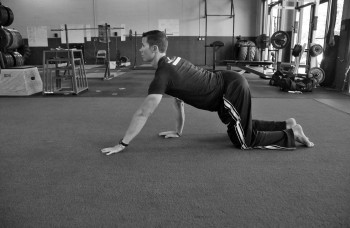Crawling Questions
Apr 05, 2015

Just some answers to a few crawling questions…
Should you crawl for extended periods of time?
Yes. Yes, you should - if you want to, and if your body is ready to. However, for some, crawling may actually be too far "down stream" for their bodies. Some people are not actually ready to start crawling as they may not have enough of a reflexive strength foundation to crawl. They may need to spend some time pressing reset with breathing, head nods, rolling and rocking before they try to spend lots of time crawling.
Why would you want to crawl for any length of time, much less extended periods of time?
Because crawling is the foundational movement to your gait pattern (walking) and it is this pattern, your gait pattern, that keeps your body healthy and strong. Crawling WAS the pattern that was intended to integrate your entire body - it is the pattern that connects your brain and the pattern that enables your body to coordinate all your parts and senses as a whole so that you are not a collection of bits and pieces. Crawling makes your body reflexively strong.
But I know people who never crawled as a child. Not everyone crawls.
True. But that doesn't mean the pattern of crawling is not inside of everyone. Everyone walks. Walking is the higher contra-lateral pattern that we were all designed to have - the pattern where our arms and shoulders should swing in opposite coordination with one another. A regression to walking would be crawling. AND, just because not everyone crawls as a child does not mean the benefits of crawling are no longer in effect. Even adults, who skipped crawling as a child, can benefit from crawling as an adult. Crawling at any age still offers health to the brain and health to the body. Also, crawling is a gentle form of loading our contra-lateral gait pattern. Gray Cook has often been quoted saying that loading a pattern makes it "stick."
But people are made to walk on two feet. We were not meant to crawl throughout our lives, much less for extended periods of time.
This is true. People are made to walk on two feet. But rarely do people let the truth stop them from doing what they want to do. Truth in design: we were made to walk, and run, on two feet - for extended periods of time. Truth in reality: most people actually sit in place for extended periods of time instead. We were not made to sit in chairs for extended periods of time, yet that is what many of us do. But rarely do you see campaigns setting out to vilify those evil chairs.
None of us would have any trouble telling our kids that if they want to be good at baseball, they have to practice baseball. They need to put in the time learning and moving through the fundamentals in the world of baseball to become great. Why would any of us assume that we are good walkers when many of us don't put in the time or practice of actually walking to be great at walking? Crawling can be great "training ground" for walking as crawling is the fundamental movement to walking. Once the foundation is truly laid, then, walking becomes the movement to be practiced and engaged in - for long periods of time.
What is an extended period of time for crawling?
I don't know. I suppose it is relative. Is ten minutes and extended period of time? It's only ten minutes. People sit for up to 8 or more hours a day. Is that an extended period of time? It also may depend on how you want to look at things. If a person spends five minutes a day doing pushups, in a year they would have performed pushups for a total of 1,825 minutes. Is that an extended period of time? It is certainly a lot of accumulated time - over 30 hours of pushups. Time frames may be relative to the one watching the clock.
Crawling is a natural movement. A movement pattern that is programmed into your nervous system. It is not a man-made movement, like say a dumbbell curl. It is actually a part of your movement design.
Performing the movements we were created for has value. How long you perform those movements is completely up to you. If you enjoy moving, move as you want to move, for as long as you want to move. If movement hurts, or seems contra-indicated at the time, seek another form of movement that you enjoy. We are all made to walk, but there may be times in our lives when we should probably "walk smart"; walking with a broken foot is not necessarily a good thing. Regardless of what you do, in everything you do, exercise good judgement.
If you want to crawl for extended periods of time, you should be able to. If you want to run for extended periods of time, you should be able to. If you want to climb a mountain, or a cliff, for extended periods of time, you should be able to. You are designed to move. You should be able to move in all the ways you want to move for as long or as much as you want to. You can - if you want to - but you don't have to.
Comments (0)
Please login to comment.